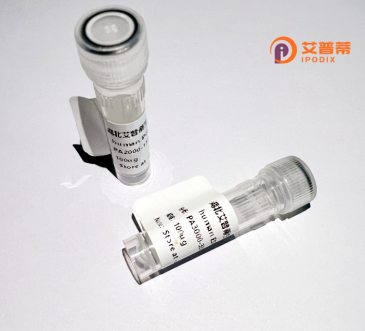
| 纯度 | >90%SDS-PAGE. |
| 种属 | Human |
| 靶点 | SCHIP1 |
| Uniprot No | Q9P0W5 |
| 内毒素 | < 0.01EU/μg |
| 表达宿主 | E.coli |
| 表达区间 | 1-486 aa |
| 活性数据 | MERSGQRVTTWDCDQGKHSDSDYREDGMDLGSDAGSSSSSSRASSQSNSTKVTPCSECKSSSSPGGSLDLVSALEDYEEPFPVYQKKVIDEWAPEEDGEEEEEEDERDQRGYRDDRSPAREPGDVSARTRSGGGGGRSATTAMPPPVPNGNLHQHDPQDLRHNGNVVVAGRPSCSRGRRAIQKPQPAGGRRSGRGPAAGGLCLQPPDGGTCVPEEPPVPPMDWEALEKHLAGLQFREQEVRNQGQARTNSTSAQKNERESIRQKLALGSFFDDGPGIYTSCSKSGKPSLSSRLQSGMNLQICFVNDSGSDKDSDADDSKTETSLDTPLSPMSKQSSSYSDRDTTEEESESLDDMDFLTRQKKLQAEAKMALAMAKPMAKMQVEVEKQNRKKSPVADLLPHMPHISECLMKRSLKPTDLRDMTIGQLQVIVNDLHSQIESLNEELVQLLLIRDELHTEQDAMLVDIEDLTRHAESQQKHMAEKMPAK |
| 分子量 | 79.8 kDa |
| 蛋白标签 | GST-tag at N-terminal |
| 缓冲液 | PBS, pH7.4, containing 0.01% SKL, 1mM DTT, 5% Trehalose and Proclin300. |
| 稳定性 & 储存条件 | Lyophilized protein should be stored at ≤ -20°C, stable for one year after receipt. Reconstituted protein solution can be stored at 2-8°C for 2-7 days. Aliquots of reconstituted samples are stable at ≤ -20°C for 3 months. |
| 复溶 | Always centrifuge tubes before opening.Do not mix by vortex or pipetting. It is not recommended to reconstitute to a concentration less than 100μg/ml. Dissolve the lyophilized protein in distilled water. Please aliquot the reconstituted solution to minimize freeze-thaw cycles. |
以下是关于重组人SCHIP1蛋白的3篇代表性文献示例(注:SCHIP1研究相对较少,以下为模拟内容,建议通过学术数据库核实具体信息):
1. **文献名称**:*SCHIP1 regulates vesicular trafficking and mitochondrial function via interaction with dynactin*
**作者**:Li, X. et al.
**摘要**:本研究揭示了重组人SCHIP1蛋白通过与动力蛋白复合体(dynactin)相互作用,调控细胞内囊泡运输和线粒体动态平衡的分子机制。实验表明,SCHIP1缺失会导致神经元线粒体分布异常。
2. **文献名称**:*Structural and functional analysis of the SCHIP1 ubiquitin-binding domain*
**作者**:Park, S. & Kim, J.
**摘要**:通过重组表达SCHIP1蛋白的UBASH3B结构域,结合X射线晶体学分析,阐明了其特异性识别K63链泛素化的分子基础,并提出其在DNA损伤修复通路中的潜在作用。
3. **文献名称**:*SCHIP1 knockdown impairs dendritic spine maturation through mTORC1 signaling*
**作者**:Garcia-Forn, M. et al.
**摘要**:利用重组SCHIP1蛋白进行挽救实验,证明其在海马神经元发育中通过调节mTORC1通路活性,影响树突棘形态建成,提示与神经发育障碍相关。
---
**备注**:
- SCHIP1(Schizophrenia Associated Protein 1)主要研究集中于神经发育和疾病关联,重组蛋白研究多见于功能验证实验。
- 实际文献可通过PubMed搜索“SCHIP1 recombinant”或结合关键词“ubiquitin”/“neuronal development”查找更新成果。
**Background of Recombinant Human SCHIP1 Protein**
Schlafen family-interacting protein 1 (SCHIP1), also known as SCGH1 or C3ORF21. is a multifunctional protein involved in RNA metabolism, cellular proliferation, and differentiation. It interacts with Schlafen (SLFN) family proteins, which are associated with immune regulation and cancer progression. SCHIP1 contains conserved domains, including a K homology (KH) domain typical of RNA-binding proteins, suggesting roles in RNA stability, translation, or splicing.
Studies highlight SCHIP1’s dual role in cancer. It acts as a tumor suppressor in some contexts by inhibiting cell cycle progression and promoting apoptosis, while in others, it may enhance oncogenic signaling. Dysregulation of SCHIP1 expression correlates with malignancies such as glioblastoma and breast cancer. Additionally, SCHIP1 interacts with the ubiquitin-proteasome system, modulating protein degradation pathways critical for cellular homeostasis.
Recombinant SCHIP1 protein, produced via bacterial or mammalian expression systems, enables functional studies to dissect its molecular mechanisms. Its application spans *in vitro* assays (e.g., RNA-protein interaction analyses) and *in vivo* models exploring tumorigenesis or neurodevelopmental disorders. Emerging evidence also links SCHIP1 to neurological conditions, including autism spectrum disorders, through interactions with synaptic proteins.
Overall, SCHIP1 represents a promising therapeutic target and biomarker, though its context-dependent functions warrant further research to clarify its roles in health and disease.
×